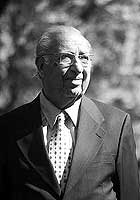|
|

|
Houshang Seyhoun
Architect
Iran, Canada
|
Houshang Seyhoun was born on a hot summer's day in Tehran (August 22, 1920). His family vitally involved in music and art. he lived in this atmosphere of music and art, and from an early age was encouraged to pursue his passion for drawing.
This extended to his decorating the finely crafted pillars of their home, black charcoal lines on stark white columns and walls and of course his parents encouraged him.
He completed his early education through secondary school in Tehran, and he graduated from high school and was admitted to the newly established College of fine arts at Tehran University, at the outbreak of the Second World War. The child's passion for drawing now extended to design and architecture, and under the careful direction of his mentor and advisor in college, French scholar professor Maxime Siroux, Seyhoun blossomed in the next four years, and outstanding young talent.
Shortly after Seyhoun's graduation, Iran Soviet Cultural Society in Tehran, which organized many cultural events, arranged for an exhibition of works by Iranian artists. Houshang's graduation project was exhibited, and judges awarded him the insignia for arts from Iranian Ministry Of Culture and Arts-an insignia, interestingly enough, which he had himself designed something earlier during a contest at the college.
In the year following the war, Seyhoun won several additional contests and prizes for his architectural designs. One of these was his design for a monument at Tehran's Central Railway Station. Soon after this achievement, he designed for the commemorative monument and mausoleum for Iranian philosopher and physician, Avecinna, in Hamadan.
In 1946 he left for France to advance his studies in Beaux-Arts. These were very important years for him. He studied under Professor Otello Zavaront for three years and traveled widely throughout Europe. By 1949, when he completed the course of study and received the "Docteur d'Art".
During the next 20 years he designed mausoleums for Omar Khayam and Nader Shah, among other Iranian notables, as well as completing the main complex of Iranian National Congress, and a large educational complex in South of Tehran. Also during this period he lectured wide in Iran, Europe and North America and conducted numerous seminars and workshops.
In 1962 Seyhoun was appointed Dean of the School of Fine Arts and Architecture at Tehran University and immediately undertook major re-struction of the College. During his tenure as Dean he also become involved in civic and governmental activities, both at home and abroad and for the first time in 1968 he exhibited his abstract designs.
At this time he became member of ICOMOS, Division of UNESCO, and served as president of Iranian Architectural Organization. During this period, he was instrumental in bringing two World Architectural Congress to Iran, one in historical Isfahan and one in Persepolis (Shiraz). In 1969, he was elected a member of the City Council for Tehran for the period of four years.
In 1968, he exhibited in Tehran featured new style of abstract drawing with pen and ink. In 1972, his work was part of the large group exhibition in Amherst, Massachusetts, USA, which included the works of Salvador Dali and Pablo Picasso. Two years later, he exhibited in Paris with the publication of a book of drawing of urban and rural areas.
In 1977, Seyhoun held exclusive exhibition at Contemporary Art Gallery in Tehran, a retrospective of his work since the early days in Paris, and other exhibitions displaying water colors, pen and ink drawings, and felts. Seyhoun is noted specially for his innovative and creative architectural design. His architectural firm became the center for the original designs using stone, brick, steel and concrete in new combinations.
In three exhibitions of Seyhoun's works, in 1977 in Tehran, were to be his last in his native country. One of these exhibitions featured his water colors, another his pen and ink drawings, and the final one his felt works.
On February 2, 1980, Seyhoun left Tehran for Paris at the invitation of French government. He remained in France until 1982, where he continued to paint and draw while holding several exhibitions.
In 1981, "Hors du temps" Museum, in the South of France, was officially opened, and one of Seyhoun's works was hung as part of the permanent exhibition. He was also given honorary citizenship. A year later, in 1982, he immigrated to Canada, where he now resides permanently.
In 1989, he was honored by the City of Los Angeles for an exhibition of his work at the University of Southern California.
|
|
|
